Wildlife populations in Catalonia have declined by an average of 25% in the last 18 years
Catalonia is experiencing a progressive and widespread decline in its biodiversity, according to the report ‘State of Nature in Catalonia 2020'.
The document highlights that the populations of vertebrates (fish, reptiles, amphibians, birds, and mammals) and invertebrates (butterflies) for which long-term monitoring data are available have lost, on average, 1 in 4 individuals. (25%) the last 18 years. The overall trend is similar as a global scale but probably with a lower intensity than the one recorded worldwide, which has been documented to reach a 60% reduction since 1970.
The report shows that the loss of biodiversity in Catalonia is not the same in the various environments or habitats: it is 54% for animal species living in rivers, lakes and wetlands, 34% for those in environments agricultural and meadows and 12% for those in forests and scrubs. At the sea, the available data indicate an unfavourable situation, although data are not complete enough.
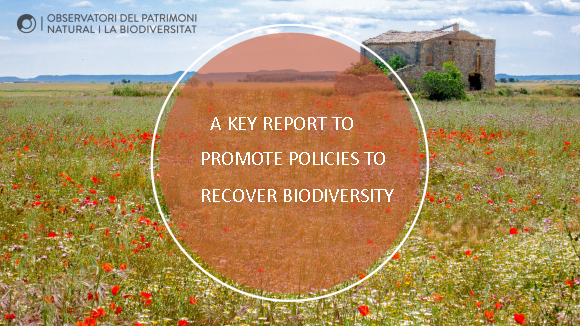
This loss of species populations in Catalonia has a direct relation with the alteration of their habitats. Changes in land use and exploitation are the main direct drivers, although the climate change and the arrival of invasive alien species are having an increasing impact. The underlying reason for this trend is a socio-economic model that intensifies resource harvesting in certain areas and abandons it in others that had been formerly used more sustainably.
A collective effort based on scientific evidence
The report ‘State of Nature in Catalonia 2020' has been commissioned by the Department of Territory and Sustainability (DTES) of the Catalan government to the Ecological and Forestry Applications Research Centre (CREAF) and the Centre for Forest Science and Technology Centre of Catalonia (CTFC), which have prepared the document together with the Catalan Institute of Ornithology (ICO) and the Institute of Marine Sciences (ICM) and with the collaboration of the technical services of the General Direction of Environmental Policies and Natural Environment of the own Department.
To do it, we have had the contribution and data of more than 40 research organizations, universities, administrations, private associations and NGOs and hundreds of volunteers, engaged in citizen science projects.
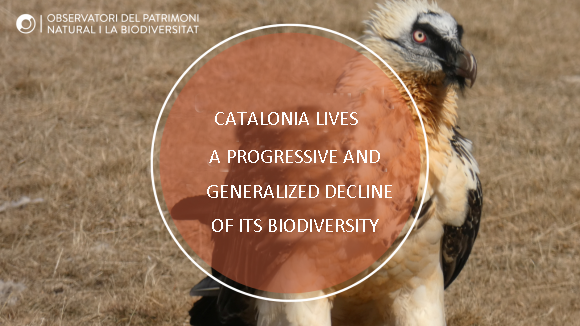
This report is a collective work and is the result of knowledge generated for decades. In Catalonia, there are some relevant documents to understand how our society is affecting biodiversity. Nature, use or abuse?. White Paper on Nature Management in the Catalan Countries (1976, 1988 and 2018-2019) and the Report on the State and Trends in the Natural Environment in Catalonia (2010) by the Institut for Catalan Studies are part of this legacy. But we must also keep in mind the effort of collective analysis that has been made in recent years and that has already been discussed in the framework of the report of the Intergovernmental Platform on Biodiversity and Services Ecosystems of the United Nations (IPBES) or in the six-yearly evaluation of compliance with the Habitats and Birds Directives commissioned by the Catalan government.
Catalonia, at state of the art with this report
This document links to reports of international and European scope, such as those that assess the fulfilment of the Aichi Biodiversity Targets - Convention on Biological Diversity, the Living Planet Index 2020, the State of Nature EU or others on a regional scale. It allows us to put in context the particular situation of our country and places us at the same level as the most advanced countries in terms of identifying conservation priorities.
It also comes at the right time because at the beginning of 2021 it is expected that the governments of the world and institutions interested in nature conservation, in the Conference of the Parties to the Convention on Biological Diversity, will take stock of the last decade and establish what has come to be called the post-2020 strategy. It is a good moment for Catalonia to also take stock of the situation and be able to participate in these debates.
The future Observatory of Natural Heritage and Biodiversity
The results of this report support the need for an ambitious and effective policy for the conservation of the natural environment and biodiversity.
The results of the in depth study support the need to pursue an ambitious and effective policy for the conservation of the natural heritage and biodiversity. In a way, it justifies the bets made by the Government over the last three years, including such as the approval of the 2030 Strategy for Natural Heritage and Biodiversity, the creation of the Nature Agency of Catalonia or the deployment of a specific economic fund for natural environment policies.
In fact, the report aims to be the start of the evaluation of the implementation of the 2030 Natural Heritage and Biodiversity Strategy. In addition, it includes some of the specific actions that have been carried out in Catalonia to reverse the loss of biodiversity. For example, protecting natural spaces through the Network of Protected Areas of Catalonia, or creating plans and actions for the conservation of endangered species. These and other actions have made possible to mitigate the loss of biodiversity and recover the populations of some highly endangered species, such as the Eurasian Otter, the Brown Bear or the Lesser Kestrel, among others.
The report is also the embryo and first step of the Observatory of Natural Heritage and Biodiversity, a public initiative that seeks to create a space for collaboration between the government of Catalonia, other administrations, research centres, universities and bodies and entities dedicated to the study of the natural environment to generate knowledge on policies related to nature. The ultimate goal is to support nature conservation policies, to be based on quantifiable indicators and scientific evidence.
The Observatory is expected to become a reality in 2021 and wants to be the reference body for obtaining, integrating, processing, accessing and disseminating information on the natural heritage in Catalonia. It is not conceived as a documentation centre or an information repository, but as a space for the generation of knowledge focused to decision-making. From the beginning, the goal is to provide answers.
A global United Nations indicator
To diagnose biodiversity in Catalonia, the global indicator used by United Nations Living Planet Index (LPI) has been adapted to the local context, which is currently based solely on information on vertebrate animals. In the case of Catalonia, as other European countries have done, information on invertebrates (butterflies only) has been added. The LPI-Cat has been calculated from trend data for 321 species, included in 7 large-scale and long-term monitoring programs that Catalonia currently has active.
More forest, but immature
Catalonia is an increasingly forested country. However, this increase in forest area does not respond to an increase in the improvement of biodiversity. The excess of young forests without proper management aimed at accelerating ecological succession and the lack of mature forests have dealt no significant improvements in animal species in forest environments.
The excess of young forests without management aimed at accelerating ecological succession and the lack of mature forests have dealt no significant improvements in animal species in forest environments.
On a scale of maturity from 1 to 10, in Catalonia forests have gone from a grade of 1.8 to a grade of 2.3. It's a positive shift but it isnot enough for the species of animals from forest environments. On the one hand, is due to the excess of young forests without a management aimed at accelerating the ecological succession and, on the other hand, to the lack of mature forests. To reach a good degree of maturity and create complex ecosystems with healthy biodiversity, forests need hundreds of years. In fact, the report concludes that the animal species most associated with the forest have remained fairly stable, while the scrub species have suffered a steady and very sharp decline, especially in butterflies, which have decreased by 57% since 1995. This is the result of the continued abandonment of many meadows and crops, which has meant that most of the area occupied by these spaces has been replaced, first for scrub, and now for growing forests.
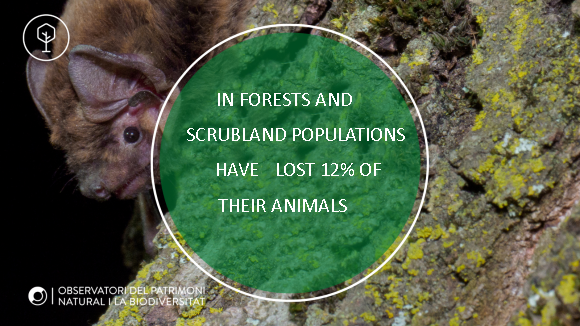
The value of sustainable agriculture
Animal populations living in meadows and agricultural environments have lost 34% of their individuals in just twenty years. The most affected species for which long-term data are available are steppe birds, which depend on dry land and fallow fields, and diurnal butterflies from meadows and pastures, which have fallen by 71%. To reverse this trend, the report covers the importance of maintaining and recovering pastures, traditional agricultural and livestock practices, crop margins and fallow land, a set of actions capable of creating vital microhabitats to keep biodiversity.
Agricultural areas suffer, on the one hand, the abandonment of less productive or steep lands and, on the other, the intensification of agriculture in the most productive and flat areas.
Agricultural areas have been immersed for decades in a dual process in Catalonia: on the one hand they have suffered from the abandonment of less productive or steep lands and, on the other, the intensification of agriculture in the most productive and flat areas. Figures in the report indicate that phytosanitary consumption has doubled in 13 years and the wealth of arable plants in cereal fields (often dubbed as weeds) has fallen by 50% in recent decades.
In the context of agricultural intensification, it's clear that certain practices associated with organic farming are beneficial, because they avoid the use of industrial synthetic plant protection products and chemical fertilizers and use crop rotation techniques. Currently the land exploited with organic farming practices (except meadows, pastures and fodder), although it is expanding strongly in Catalonia, with more than 61,000 hectares, still represents only 7.1% of the total cultivated area in the country.
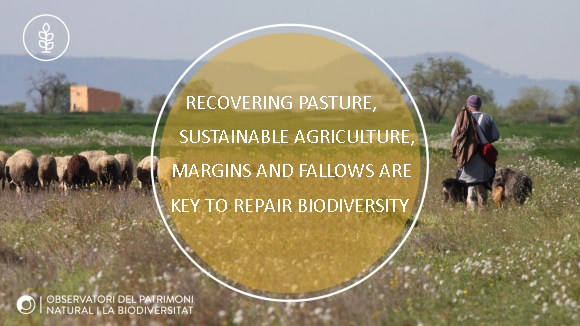
Excess of human pressure in rivers
Human activity seriously affects the rivers of Catalonia and, therefore, is where biodiversity is suffering the most critical consequences. There is a clear regression of animal populations in rivers and lakes, which have lost 50% of their individuals in the last twenty years. In addition, almost 80% of the species evaluated present an unfavourable conservation status, especially native fish species that have lost in average 9 out of 10 individuals, mainly due to pressure from exotic fish. Currently, invasive alien species are found in 64% of river courses and 73% of wetlands.
In addition to exotic species, inland waters have suffered the effects of catchments, pollution and artificialization that affect more than half of the Catalan rivers, with the occupation of alluvial plains and riverbeds, and with the consequent loss of riverbanks and the habitats they occupy.
Despite the fact that urban, agricultural and industrial wastewater still pollutes 45% of river courses, the Catalans Wastewater Treatment has substantially improved the water quality of many rivers in the last 40 years. These improvements do not yet have a direct impact on improving biodiversity due to the inertia of biological systems, but some positive indicators are already being detected, such as the growing presence of aquatic invertebrates. This improvement can be seen even in rivers such as the Llobregat, exposed to multiple human impacts, where the return of an emblematic animal such as the Eurasian Otter has been reported.
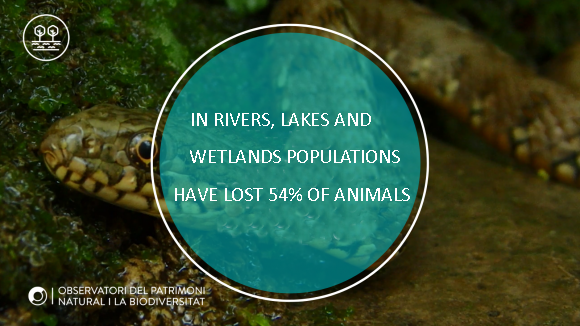
A diverse and unknown sea
The diagnostic document highlights the richness of marine biodiversity in Catalonia, but lacks basic information on its status to ensure its conservation.
The Mediterranean is home to high marine biodiversity: less than 1% of the planet's marine surface is home to 10% of all marine species, of which 30% are endemic.
The Mediterranean is home to a high level of marine biodiversity: less than 1% of the planet’s marine surface is home to 10% of all marine species, of which 30% are endemic. However, overfishing, demographic pressure on the coast, and climate change are having increasingly important impacts on the marine environments of the Catalan coasts. In the case of fishing, the report points out that, globally, 33.1% of fish of commercial interest are being overexploited, and that in the Mediterranean this also affects other species of commercial interest such as shrimp and cephalopods. Also, fishing techniques such as trawling impoverish the seabed and catch accidentally threatened species. This is the case of some cartilaginous fish (in Catalonia 65% of sharks and 42% of the rays are already considered endangered), turtles and birds (especially shearwaters). The report highlights the importance of marine reserves for the recovery of many species, citing the Medes Marine Partial Nature Reserve, where fish populations have increased, especially within the reserve, but also in the peripheral area.
On the other hand, it is clear that climate change is having obvious effects on the Catalan marine environment, with the proliferation of species associated with water warming, such as some jellyfish and filamentous algae, and the recurrence of marine heat waves, which are causing increasingly frequent episodes of mass mortality of different species. These episodes often affect species of commercial interest, such as mussels in the Ebro Delta.
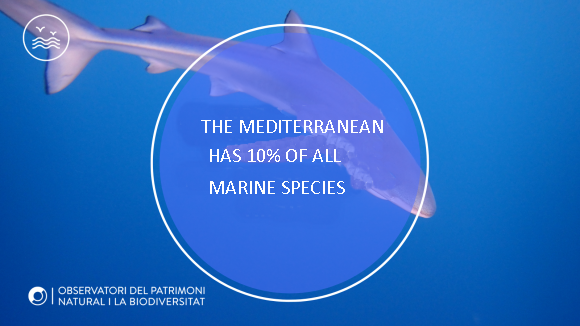
Catalonia, a key territory in terms of conservation
There are 173 species living in Catalonia that are considered endangered on the planet, of which more than 10% are fish, amphibians and reptiles. And, at the same time, the Catalan territory hosts 245 species and 99 habitats of community interest, included in the European directives for the protection of nature (Habitats Directive and Birds Directive). The case of birds is especially noteworthy, as in Catalonia there are up to 89 species of birds of community interest of regular presence, representing 44% of the birds included in the Birds Directive, in only 0.7% of the total area of the European Union. However, in December 2019 the Catalan results were published, which are included in the follow-up of these directives and which pointed out that Catalonia had to strengthen its biodiversity conservation policies because 75% of the species and 58% of the habitats of community interest presented an unfavourable conservation status.







